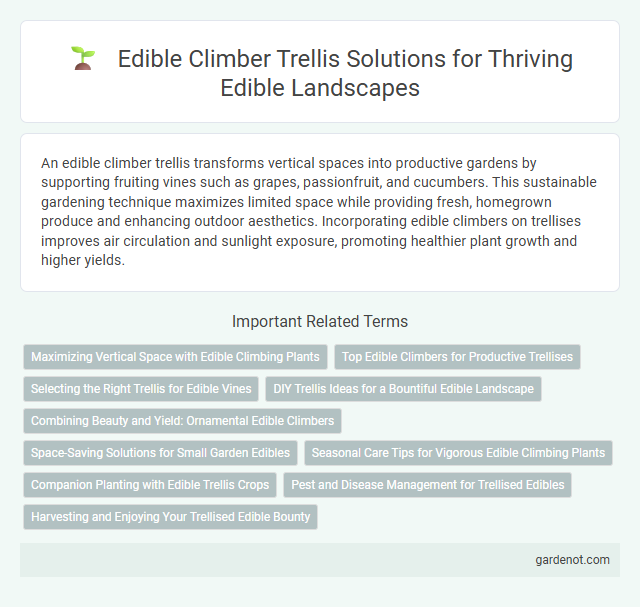An edible climber trellis transforms vertical spaces into productive gardens by supporting fruiting vines such as grapes, passionfruit, and cucumbers. This sustainable gardening technique maximizes limited space while providing fresh, homegrown produce and enhancing outdoor aesthetics. Incorporating edible climbers on trellises improves air circulation and sunlight exposure, promoting healthier plant growth and higher yields.
Maximizing Vertical Space with Edible Climbing Plants
Edible climber trellises transform vertical spaces into productive gardens by supporting plants such as peas, beans, and cucumbers, maximizing yield in limited areas. These structures optimize sunlight exposure and airflow, enhancing plant health and fruit quality while conserving ground space. Integrating perennial edible climbers like kiwi or passionfruit further increases harvest diversity and garden sustainability.
Top Edible Climbers for Productive Trellises
Top edible climbers for productive trellises include passionfruit, kiwi, and hardy grapes, all known for high yields and nutrient-rich fruits. These plants efficiently maximize vertical garden space, offering continuous harvests throughout the growing season. Integrating such climbers into trellis designs enhances both garden aesthetics and food sustainability.
Selecting the Right Trellis for Edible Vines
Selecting the right trellis for edible vines involves considering factors such as the vine's weight, growth habit, and sunlight requirements. Materials like wood, metal, or bamboo offer durability and support, while spacing and height should accommodate mature vine spread and ease of harvest. Proper trellis design enhances airflow and maximizes fruit production for crops like grapes, passionfruit, and beans.
DIY Trellis Ideas for a Bountiful Edible Landscape
Create a sturdy edible climber trellis using materials like bamboo, reclaimed wood, or metal pipes, ensuring strong support for plants such as beans, peas, and cucumbers. Incorporate vertical garden techniques by installing lattice panels or A-frame structures that maximize space and sunlight exposure. Regular pruning and secure tying of vines promote healthy growth and increase the yield of your edible landscape.
Combining Beauty and Yield: Ornamental Edible Climbers
Ornamental edible climbers such as passionfruit, honeysuckle, and scarlet runner beans create vibrant trellises that enhance garden aesthetics while producing delicious fruits and vegetables. Integrating these plants maximizes space by blending decorative appeal with functional yield, making them ideal for small or urban gardens. Their rapid growth and striking blooms attract pollinators, contributing to a healthy and productive ecosystem.
Space-Saving Solutions for Small Garden Edibles
Edible climber trellises maximize vertical growing space, making them ideal for small garden edibles like peas, beans, and cucumbers. Utilizing strong, durable materials such as metal or bamboo ensures long-lasting support for vines while optimizing sunlight exposure. Incorporating compact, space-saving trellis designs enhances garden productivity by allowing more plants in limited areas without compromising airflow or maintenance access.
Seasonal Care Tips for Vigorous Edible Climbing Plants
Edible climber trellises require consistent seasonal care to promote strong growth and abundant harvests. In spring, apply balanced organic fertilizer to support new shoots and ensure the trellis is secure for heavy fruit loads. During summer, maintain regular watering and prune excess foliage to enhance air circulation and prevent disease in edible climbing plants like peas, beans, and passionfruit.
Companion Planting with Edible Trellis Crops
Edible climber trellises maximize vertical space by supporting crops like peas, beans, and cucumbers, which thrive alongside companion plants such as nasturtiums and radishes to naturally deter pests and enhance growth. Integrating companion planting with edible trellis crops improves soil health, attracts beneficial insects, and increases overall yield in edible landscapes. This sustainable approach promotes biodiversity and efficient resource use in small garden spaces.
Pest and Disease Management for Trellised Edibles
Effective pest and disease management for edible climbers on trellises involves regular monitoring for common pests such as aphids, spider mites, and caterpillars, which can damage leaves and reduce yield. Implementing integrated pest management (IPM) techniques, including natural predators like ladybugs, organic insecticidal soaps, and proper pruning to improve air circulation, helps minimize fungal infections and pest infestations. Maintaining healthy soil conditions with balanced nutrients and avoiding water stress further enhances plant resistance against diseases, ensuring a productive and sustainable edible trellis system.
Harvesting and Enjoying Your Trellised Edible Bounty
Harvesting your edible climber trellis ensures fresh, nutrient-rich produce like peas, beans, and cucumbers at peak ripeness. Regular picking encourages continuous growth and maximizes yield throughout the season. Enjoying these homegrown delights enhances meals with vibrant flavors while promoting sustainable gardening practices.
Edible climber trellis Infographic

 gardenot.com
gardenot.com